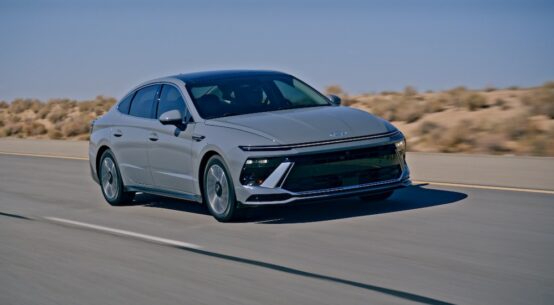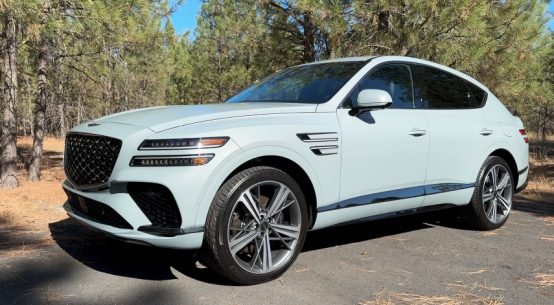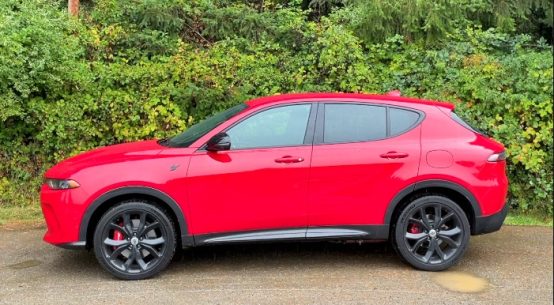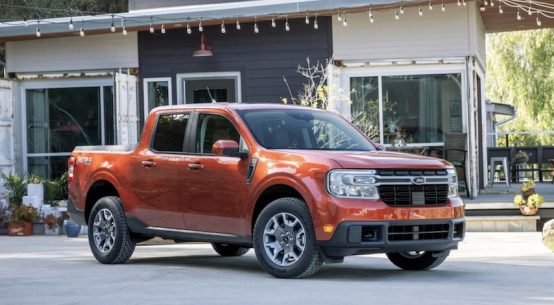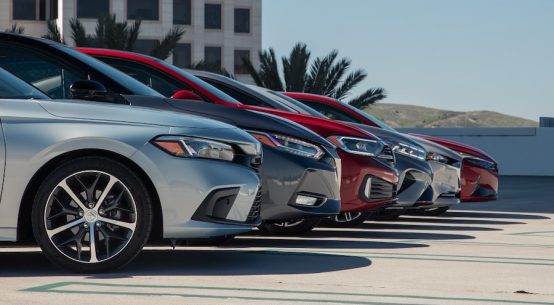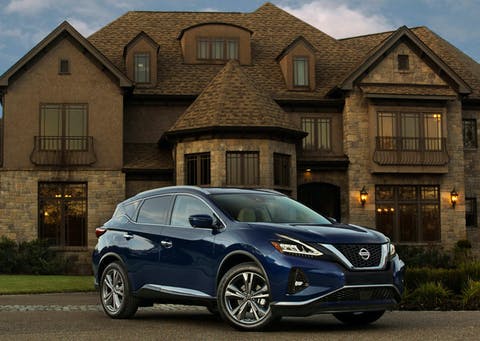
We begin with number ten. The Nissan Murano is a family-oriented SUV with excellent seats and nice materials, making it a comfortable people mover. Poor visibility, dated-feeling technology, and some quirks in the powertrain keep it from being a top pick.
Nissan employs a powerful 3.5-liter V6 for the Murano. The engine makes 260 hp and 240 lb-ft of torque, which is plenty for driving the family around town and getting up to highway speeds. Nissan has long used 3.5-liter V6 engines, and this one feels quiet and refined. It comes with a single-speed, continuously variable transmission, which helps make the Murano more fuel-efficient.
The EPA estimates a respectable 20/28/23 mpg city/highway/combined. All-wheel-drive is available for four-season peace of mind. The Murano has a below-average towing capacity, with just 1,500 lbs at its disposal. $32,610 – $45,710. (Free Price Quote)
The Blazer isn’t the off-road scrambler you may remember from years ago. Today’s Blazer is better suited to on-road performance thanks to its sharp handling and comfortable ride. Its small cargo capacity limits its utility, but advanced tech broadens its appeal.
As sporty as the Blazer looks, most of the powertrain options don’t meet expectations. The base 2.5-liter four-cylinder engine makes 193 horsepower. It’s slow to accelerate and cannot tow very much. Many similarly-sized rivals offer base engines with nearly 300 horsepower. According to the EPA, fuel economy is 23 mpg overall, which isn’t very competitive.
A turbocharged four-cylinder is available, and it makes 227 horsepower. The turbocharger gives the Blazer more rapid acceleration and much better passing power, but the engine still lacks in sheer muscle. EPA mileage goes up slightly, to 24 mpg combined.
The RS trim’s 308-horsepower 3.6-liter V6 should be standard on all Blazers. It offers smooth power delivery, and it feels capable in all driving situations. It’s the best engine of the pack, though fuel economy is a below-average 21 mpg overall.
The Blazer lineup comes standard with front-wheel-drive, though power can go to all wheels for an extra fee. All engines use regular unleaded gasoline and connect to a 19.4-gallon fuel tank. With the V6 engine and optional towing package, the Blazer can tow up to 4,500 pounds, placing it in the middle of the segment. $28,800 – $45,800. (Free Price Quote)
The Jeep Grand Cherokee is a versatile SUV that can be equipped as a luxurious road-going vehicle, an off-road specialist, or even a legitimate hot rod. Top trim levels come with a hefty price tag, and the Grand Cherokee’s age is starting to show.
Most trims are powered by a 295-horsepower V6 engine that gets an EPA-estimated 21 mpg combined. That’s not very competitive against other midsize SUVs, some of which offer hybrid powertrains as well. Despite that, the Grand Cherokee’s V6 provides excellent power delivery and up to 6,200 pounds of towing, making it great for everyday jobs. A 5.7-liter Hemi V8 engine is available optionally on upper trim levels.
All Grand Cherokees employ an eight-speed automatic transmission, and rear-wheel-drive comes standard. Four-wheel-drive with low-range is available.
The SRT performance trim has a 475-horsepower 6.4-liter V8 that makes 470 pound-feet of torque. It’s swift, and it gets 15 mpg overall in EPA testing. The Trackhawk’s supercharged 6.2-liter V8 generates an incredible 707 horsepower and 645 pound-feet of torque. It offers unbelievable acceleration and cornering for an SUV, and is expected to get 13 mpg combined. Both trims can tow up to 7,200 pounds. $34,395 – $87,870. (Free Price Quote)
Built on a truck frame and backed by a reputation for reliability, the Toyota 4Runner is one of the toughest SUVs on the market. Its off-road abilities and cargo space make it a great adventure vehicle. SUVs like the 4Runner lag in popularity compared to car-based crossovers due to their inferior on-road handling and fuel economy. Yet no crossover can match the all-terrain talents or durability of the Toyota 4Runner.
No matter which 4Runner one chooses, it will come with Toyota’s trusted and longstanding 4.0-liter V6 engine. It produces 270 horsepower and 278 pound-feet of torque. The engine delivers plenty of power for everything from highway cruising to rock-crawling. It is mated to a 5-speed automatic transmission. The 4Runner takes regular fuel and has a 23-gallon gas tank.
The EPA estimates the two-wheel-drive 4Runner should return 16/19/17 mpg city/highway/combined, which lags behind many midsize crossover SUVs. $36,590 – $50,57 (Free Price Quote)
Superior comfort and passenger space, along with a whisper-quiet cabin, and robust Sync3 infotainment system make the Ford Edge an appealing SUV. It’s consistently well-executed, though the cabin ambiance at higher trim levels is at odds with the price point.
The SE, SEL, ST-Line, and Titanium use a 2.0-liter twin-scroll EcoBoost four-cylinder engine producing 250 horsepower and 275 lb-ft of torque. The motor makes adequate power for driving around town and on the highway. The Edge’s unibody construction and fully-independent suspension help provide car-like handling. That power moves through an eight-speed automatic transmission. You can expect to get around 24 mpg in mixed driving with front-wheel-drive.
Stepping up to the ST equips an entirely different powertrain. This one, a 2.7-liter EcoBoost V6, makes an impressive 335 horsepower and 380 lb-ft of torque. It provides quick acceleration with a seven-speed transmission. The ST’s sport-tuned suspension and 20-inch wheels give it a firm ride, improving handling but impacting the Edge’s smooth ride. Standard all-wheel-drive and the potent V6 powertrain sap some efficiency, too, lowering EPA estimates to 21 mpg overall. $31,100 – $43,265. (Free Price Quote)
The Subaru Outback offers excellent ground clearance and capable all-wheel drive. It’s a go-anywhere vehicle with car-like driving qualities on paved roads, making it a more versatile choice than many SUV competitors.
You can choose between two engines for their Outback. The entry-level 2.5-liter four-cylinder is smooth and quiet but a tad slow, making 182 horsepower and 176 pound-feet of torque. The available 2.4-liter turbo is much more fun to drive, and it produces 260 horsepower and 277 pound-feet of torque.
The EPA estimates fuel economy for the base motor to be 29 mpg combined, which is excellent for a midsize crossover SUV. The turbocharged engine will be worth the jump in price for many shoppers, though, even despite its adequate 26 mpg average. Subaru employs a continuously-variable transmission, which operates just like an automatic transmission.
Subaru uses computer programming to mimic gear changes despite the gearbox only having a single gear. It is a transmission type commonly found in hybrid cars, and it is undoubtedly part of the reason the heavy all-wheel-drive Subaru gets such competitive gas mileage. Both engines run on regular unleaded fuel, and the Subaru features an 18.5-gallon fuel tank. $26,795 – $39,945. (Free Price Quote)
The Hyundai Santa Fe impresses with its design and usability. It’s loaded with infotainment and safety goodies, and its taut suspension helps it handle curves well. Relatively weak engine choices and mediocre fuel economy are its main downsides.
Hyundai offers three recently-improved engines for the latest Santa Fe. Entry-level trims use a Smartstream 2.5-liter 4-cylinder engine connected to an 8-speed automatic transmission. It makes 191 horsepower and 182 pound-feet of torque, which is plenty of power for a range of driving situations and weather conditions. The powertrain includes stop-and-go engine capability that switches the engine off at idle to save fuel, automatically restarting it when the gas pedal is depressed. The EPA estimates fuel economy of 25/28/26 MPG city/highway/combined. It’s a significant upgrade over the outgoing engine’s efficiency.
The Santa Fe is also available with a Smartstream 2.5-liter turbocharged 4-cylinder mated to an 8-speed dual-clutch transmission (DCT). This motor replaces an old 2.0-liter turbo. It makes 277 horsepower and 311 pound-feet of torque, which provides much quicker acceleration and effortless passing on the highway. The DCT behaves like a regular automatic transmission, but its architecture allows it to make rapid gear changes, giving the Santa Fe a sportier feel than many SUVs. The powertrain should return about 22/28/25 MPG city/highway/overall.
A long-awaited hybrid is now available, too. The Smartstream 1.6-liter turbo 4-cylinder comes standard with HTRAC all-wheel-drive and a 6-speed automatic transmission. The transmission is specially tuned to balance fuel economy with driving performance. The turbocharged engine generates 178 horsepower and 225 pound-feet of torque. The hybrid system employs an HEV starter-generator for cabin electronics and an electric motor that provides additional driving power. The hybrid starter-generator uses a lithium-ion polymer battery pack with a 64 kW output. Official fuel economy numbers haven’t been released yet, but drivers could expect overall returns around 30 MPG. $26,275 – $39,575. (Free Price Quote)
Toyota resurrects its Venza to once again compete in the midsize SUV segment. Offered solely as a hybrid, it’s easily the most efficient choice in the segment, but it’s also surprisingly quick. Toyota shot the moon with this one.
The Toyota Venza utilizes a hybrid powertrain that consists of a 2.5-liter 4-cylinder engine paired with front and rear electric motors powered by a 252-volt lithium-ion battery. Together they make 219 horsepower and 163 pound-feet of torque. Power is sent to the Venza’s all-wheel-drive setup through a continuously variable transmission (CVT).
The Venza gets an EPA estimated 40/37/39 mpg city/highway/combined. $32,470 – $39,800. (Free Price Quote)
To make the Cross Sport, VW took its successful three-row Atlas SUV, ditched the third-row seating and added a more rakish roofline. It’s a roomy and comfortable five-passenger midsize SUV that’s also stylish.
Volkswagen offers two engines for the Atlas Cross Sport — a 2.0-liter turbocharged four-cylinder or a 3.6-liter V6. Both utilize a start/stop system to maximize fuel efficiency by turning off the engine while idling. When the brake pedal is released, the engine is restarted.
The 2.0-liter four-cylinder turbo produces 235 hp and 258 lb-ft of torque using premium fuel. Along with a standard remote engine starter, the SE with Technology and higher trims can be equipped with a more powerful 3.6-liter V6 engine, which produces 276 hp and 266 lb-ft of torque.
Both engines mate with an eight-speed automatic transmission. Front-wheel-drive is standard. The Atlas Cross Sport’s standard towing capacity is 2,000 lbs; adding the V6 and optional trailer hitch boosts towing to 5,000 lbs.
For models fitted with the 2.0-liter four-cylinder engine and front-wheel-drive, the EPA estimated gas mileage of 21/24 mpg city/highway. Models with both the V6 engine and 4Motion all-wheel-drive are expected to return 17/23 mpg. These are uncompetitive efficiency figures for the midsize SUV class.
The Atlas Cross Sport’s optional 4Motion all-wheel-drive system uses advanced control functionality to help enhance traction in all driving situations. The system stays in front-wheel-drive mode in normal driving conditions, with the rear wheels decoupled from power. When needed, the system can activate in well under one second, sending up to 50-percent of the engine’s power to the rear axle. $30,855 – $50,025. (Free Price Quote)
The top-ranked Honda Passport is one of the most versatile midsize SUVs in the market. It exudes athletic qualities but also delivers a comfortable ride, tons of passenger and cargo space, and a good list of standard features. Put this at the top of your list.
Like the straightforward trim choices, Honda’s powertrain options are exceedingly simple, with just one engine and transmission available. Shoppers need only to choose between front- and all-wheel-drive.
The Passport’s engine is a 280-horsepower 3.5-liter V6 that runs on regular unleaded gas and makes 262 pound-feet of torque. The EPA estimates fuel economy of 22 mpg combined; all-wheel-drive returns 21 mpg. The engine comes with a start/stop system that automatically turns the engine off at idle and back on when the throttle is depressed, a technology that helps save fuel. The engine provides smooth power and plenty of speed for passing cars on the highway, but some rivals get better fuel economy, and no hybrid powertrain is offered on the Passport.
The engine mates to a nine-speed automatic transmission, with paddle shifters, should the driver want to change gears manually. Front-wheel-drive Passports have a 3,500-pound towing capacity, while all-wheel-drive makes 5,000 pounds available to drivers. $32,590 – $43,980. (Free Price Quote)
